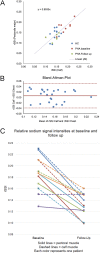Primary hyperaldosteronism induces congruent alterations of sodium homeostasis in different skeletal muscles: a 23Na-MRI study
- PMID: 35255003
- PMCID: PMC9010811
- DOI: 10.1530/EJE-22-0074
Primary hyperaldosteronism induces congruent alterations of sodium homeostasis in different skeletal muscles: a 23Na-MRI study
Abstract
Background: Sodium homeostasis is disrupted in many cardiovascular diseases, which makes non-invasive sodium storage assessment desirable. In this regard, sodium MRI has shown its potential to reveal differences in sodium content between healthy and diseased tissues as well as treatment-related changes of sodium content. When different tissues are affected disparately, simultaneous assessment of these compartments is expected to provide better information about sodium distribution, reduce examination time, and improve clinical efficiency.
Objectives: The objectives were (1) to investigate sodium storage levels in calf and pectoral muscle in healthy controls and patients and quantify changes following medical treatment and (2) to demonstrate homogeneous disruption in skeletal muscle sodium storage in patients with primary hyperaldosteronism (PHA).
Methods: We assessed sodium storage levels (relative sodium signal intensity, rSSI) in the calf and pectoral muscles of eight patients with PHA prior and after treatment and 12 age- and sex-matched healthy volunteers.
Results: Calf and pectoral muscle compartments exhibited similar sodium content both in healthy subjects (calf vs pectoral rSSI: 0.14 ± 0.01 vs 0.14 ± 0.03) and PHA patients (calf vs pectoral rSSI: 0.19 ± 0.03 vs 0.18 ± 0.03). Further, we observed similar treatment-related changes in pectoral and calf muscles in the patients (proportional rSSI change calf: 26%; pectoral: 28%).
Conclusion: We found that sodium was distributed uniformly and behaved equally in different skeletal muscles in Conn's syndrome. This allows to measure both heart and skeletal muscle sodium signals simultaneously by a single measurement without repositioning the patient. This increases 23Na-MRI's clinical feasibility as an innovative technique to monitor sodium storage.
Figures



References
-
- Christa M, Weng AM, Geier B, Wörmann C, Scheffler A, Lehmann L, Oberberger J, Kraus BJ, Hahner S, Störk Set al.Increased myocardial sodium signal intensity in Conn’s syndrome detected by 23Na magnetic resonance imaging. European Heart Journal: Cardiovascular Imaging 201920263–270. (10.1093/ehjci/jey134) - DOI - PMC - PubMed
-
- Gerhalter T, Gast LV, Marty B, Martin J, Trollmann R, Schüssler S, Roemer F, Laun FB, Uder M, Schröder Ret al.23 Na MRI depicts early changes in ion homeostasis in skeletal muscle tissue of patients with duchenne muscular dystrophy. Journal of Magnetic Resonance Imaging 2019501103–1113. (10.1002/jmri.26681) - DOI - PubMed
MeSH terms
Substances
LinkOut - more resources
Full Text Sources

